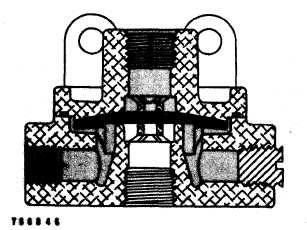TM 5-3805-258-24-1
SYSTEMS OPERATION
A I R S Y S T E M A N D B R A K ES
A I R C I R C U I T F O R T H E E M E R G E N C Y A N D P A R K I N G B R A K E
QUICK RELEASE VALVE FOR EMERGENCY
AND PARKING BRAKE
Q U I C K R E L E A S E V A L V E I N A P P L Y I N G P O S I T I ON
1. Outlet port, 2. O-ring seal. 3. Cover. 4. Inlet port. 5.
Diaphragm. 6. Body. 7. Exhaust port. 8. Plug.
The quick release valve hastens the exhaust of air
from the brake chamber for the emergency and park-
ing brake. The quick release valve has three positions
during operation. These positions are the APPLY-
ING position, when air under pressure passes
through the valve into the brake chamber; the
HOLD position, when pressure is held in the brake
chamber; and the RELEASE position, when the
brake chamber exhausts.
Q U I C K R E L E A S E V A L V E I N H O L D I N G P O S I T I ON
When the parking brake disengages (control valve
in OFF position), air under pressure enters inlet port
(4) of the quick release valve, and moves diaphragm
(5) down, closing exhaust port (7). The outer edges
of the diaphragm are deflected downward. Pressure
air passes through outlet port (1) to the brake
chamber.
Q U I C K R E L E A S E V A L V E I N R E L E A S E P O S I T I ON
As soon as the brake chamber pressure below the
diaphragm equals the control valve pressure above
the diaphragm, the edge of diaphragm (5) is forced
up against cover (3). The center of the diaphragm
continues to cover exhaust port (7). This is the
HOLDING position.
When the control valve for the emergency and
parking brake is moved to ON position, air pressure
on the top of the diaphragm is released. The brake
chamber pressure below the center of the diaphragm
raises it, opening exhaust port (7) and permitting the
brake chamber air to exhaust (RELEASE position).
L O C A T I O N O F Q U I C K R E L E A S E V A L VE
BRAKE CHAMBER FOR EMERGENCY AND
PARKING BRAKE
Brake chamber (6) releases (disengages) and acti-
vates (engages) the emergency and parking brake.
Brake chamber rod (3) is connected to rod end (7).
Rod end (7) is connected to lever (8) which moves the
shoes in the brake. When there is no pressure from
the control valve for the emergency and parking
brake, there is no air pressure in air chamber (2).
Spring (1) holds piston (4) all the way to the right
and keeps the emergency and parking brake
engaged.
3-76







